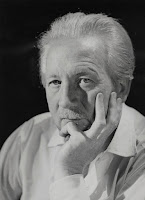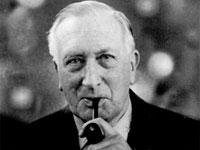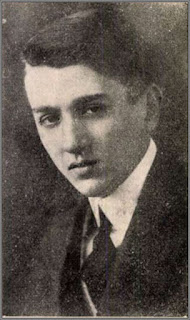Best British Symphonies: 9. "Modernist" Symphonies - Part 1
Havergal Brian, Cyril Scott, Sir Arthur Bliss, Sir Eugene Goossens, Edmund Rubbra, Sir William Walton;
Cyril Scott (1879 - 1970), although first and foremost a musician and composer, was equally a poet, drawn to all things philosophical, metaphysical and occult, and with a keen interest in alternative medicine and alchemy. From his total of four symphonies, however, only his third "The Muses" for chorus and orchestra (1937) has received some recognition. Still in the traditional four-movement form, each one is headed by one of the muses of the Greek mythology: Melpomene, Thalia, Erato & Terpsichore. Since his musical style was heavily influenced by his way of thinking, it lead him to expand the traditional tonal and rhythmical systems, making Scott one of the first true 'modernists' from the British isles, despite, sadly, a later decline of interest in his work.
Sir Arthur Bliss (1891 - 1975) came to be recognized chiefly for his ballets and film scores as well as his music for ceremonial occasions, but he is also the author of some excellent concertos (piano - 1938, violin - 1953 & cello - 1970), chamber music, choral music and operas. Although he only wrote one symphony, his "A Colour Symphony" from 1921/22 was actually inspired by Elgar and, written for the 1922 Three Choirs Festival, first performed at Gloucester Cathedral. Bliss composed - in Elgar's words - a "disconcertingly modern" piece in which he decided to portrait the symbolic meanings of four colours (Purple, Red, Blue & Green) within each of the four movements - whilst still corresponding with the overall traditional structure of a symphony. His energetic, brilliantly written work eventually became a success and placed Bliss firmly on the map as a main representative of a new generation of British composers.
Sir Eugene Goossens (1883 - 1962) will, of course, be mainly remembered as a conductor of some fame. Just like many other great conductors of his time - e.g. Weingartner, Klemperer and Furtwängler, or later Bernstein and Previn - he was also a reputable composer, having studied under Stanford at the Royal College of Music. After learning his conducting trade with Henry Wood and Thomas Beecham, he spent much of his time in America and Australia. The musical influence of the New World, especially of their respective contemporary composers, such as Copeland and Ives, clearly reflects in the style of his own works, and his oeuvre includes chamber music, orchestral pieces, concertos (including an oboe concerto for his brother Leon), two operas and two symphonies (1938-40 & 1942-45). These two vivid and imaginative symphonies - both written in the traditional four movement form - have been recorded for Chandos (together with the piano and violin "Phantasy" concertos) with the Melbourne Symphony Orchestra under Richard Hickox and Andrew Davis.
The greatest achievement of Edmund Rubbra (1901 - 86) are, without doubt, his eleven symphonies. Ranging from one single movement to three and four, with his 9th being a full blown oratorio for solo voices, chorus and orchestra ("Sinfonia Sacra - The Resurrection"), Rubbra abandoned any notions of the traditional form and thematic construction of the genre, in favour of certain melodic, harmonic and rhythmical flexibilities - and counterpoint, which each in turn becoming more progressive through the three main stages of the symphonies' gestation (symphonies 1 - 4 were written from 1937-42, no's 5 - 7 from 1947-57, and 8 - 11 from 1968-79). As a deeply religious person - he converted to Catholicism in 1947 - a generally reserved, at times sombre mood prevails, paired with reminiscences of earlier Tudor church music. The complete symphonic cycle has been recorded for Chandos by the BBC National Orchestra of Wales under Richard Hickox.
His 2nd Symphony (1957-60) - much shorter, in three movements (playing time under 30 minutes, compared to almost 45' of the 1st) - is more reserved and introvert, less youthful than its predecessor. It thus received significantly less attention, and remained in the shadow of Walton's more 'showy' works, despite a number of recordings being issued over the years, and despite of its many hidden musical treasures.
During the 20th century, a great number of British composers had moved away from the traditions of Parry, Stanford and Elgar, yet they had taken a very different path to the newly emerging English Folk Song movement of Vaughan Williams, Holst or Moeran. They had instead adapted to the 'modernist' tendencies which prevailed on the continent during the decades following WWI; however, all composers treated in this post still included the symphonic genre in their often quite varied musical styles and contributions, and awarded it a central role within their outputs.
***
The monumental 1st Symphony "The Gothic" by Havergal Brian (1876 - 1972) has already been discussed before. Brian has, however, left a legacy of no less that 32 symphonies, written between 1919-68, making him the most prolific British symphonist of modern times. The works vary greatly in size, instrumentation (apart from the "Gothic", no. 4 is scored for solo soprano, choir and orchestra, no. 5 for baritone and orchestra), character and duration of play, yet the majority keeps faithfully in line with the traditional formal structure of the romantic symphony. All 32 works have now been recorded.
***
 |
| Cyril Scott |
Courtesy to the Chandos Label and the conductor Martyn Brabbins, all four symphonies are now available as commercial recordings, together with many of his other fascinating works: chamber and piano music, concertos and songs. His operas have, however, not been recorded, although excerpts from "The Alchemist" were published in the past.
***
 |
| Arthur Bliss |
"A Colour Symphony" has been recorded many times by a number of leading British conductors, including Vernon Handley, David Lloyd-Jones, Richard Hickox - and by the composer himself.
***
 |
| Eugene Goossens |
***
 |
| Edmund Rubbra |
***
Just like Arthur Bliss, Sir William Walton (1902 - 83) has written many notable film scores, ballets and incidental music, chamber and orchestral music, choral works as well as two operas. His symphonic output, however, includes two very different works: the 1st Symphony in B-flat minor (1932-34) received an enthusiastic welcome from the outset, and has become one of the most performed British contributions to its genre, not only by Walton, but of the post-Elgarian period. It immediately consolidated Walton's place as one of the countries leading young composers. Written in the traditional four-movement form (I. Allegro assai, II.Scherzo: Presto con malizia, III. Andante con malinconia IV. Maestoso - Allegro, brioso ed ardentemente), with rhythmical verve, vividly scored and containing much contrapuntal detail, the work has immediately been associated with Sibelius (presumably referring to the latter's 2nd and 5th Symphonies).
 |
| William Walton |
The 1st Symphony has been recorded by almost all leading British, and by many international conductors and orchestras. Although this makes it hard to pick a top performance, one of my personal favourites must be the 1967 reading by the LSO under André Previn.


Comments
Post a Comment